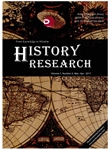The Recompositions of Buus'(1547)RicercariFrom His Libro primo.., in Manuscript P-Cug MM 242 and the Didactic Processes of the Friars of the Santa Cruz Monastery in Coimbra.
The Recompositions of Buus'(1547)RicercariFrom His Libro primo.., in Manuscript P-Cug MM 242 and the Didactic Processes of the Friars of the Santa Cruz Monastery in Coimbra.作者机构:Universidade de l~vora l~vora Portugal
出 版 物:《History Research》 (历史研究(英文版))
年 卷 期:2013年第3卷第6期
页 面:423-440页
学科分类:01[哲学] 0101[哲学-哲学] 010107[哲学-宗教学] 081203[工学-计算机应用技术] 08[工学] 0835[工学-软件工程] 0812[工学-计算机科学与技术(可授工学、理学学位)]
主 题:Jacques Buus P-Cug MM 242 Ricercare Portuguese instrumental music from the 16h century Scoreformat manuscripts
摘 要:The purpose of this articleis to address the presence of seven recomposed ricercari by Jacques Buus in the Music Manuscript 242 from the Library of the University of Coimbra in Portugal (P-Cug MM 242). These recompositions, probably copied in the third quarter of the 16th century, were made after the previously copied Buus's ricercari in Music Manuscript 48 (P-Cug MM 48) of the same library, which were based on the Libro primo de ricercari a quattrovoci, published in Venice in 1547 by Antonio Gardane. In this paper, the author intend to focus in two main aspects of the research done on this subject. The first topic concerns the score-format of both manuscripts 48 & 242, which testify the instrumental activity in mid-sixteenth century Portugal. The author will demonstrate that this format served once, in the Santa Cruz Monastery in Coimbra, as a didactic tool in the teaching of counterpoint through the music of a northern European master such as Jacques Buus. The copies in the manuscripts were never intended to be used as a performing support--they contain many errors of vertical coordination between the voices that make the performance impossible. The second topic focuses on Buus' recomposed ricercari, which were the object of many cuts, brief recomposed bridges, newly inserted sections, and written glosa figurations. Through these recompositions, the author will describe the theoretic assimilation of formal processes, of style, mode, counterpoint and performing practice. The achievement of this paper is to offer historic musicology researchers a new perspective about the enormous influence that Buus' ricercari from his Libro primo.., had in the learning processes of music composition and in the development of didactic and performing practices in the Santa Cruz Monastery in Coimbra, during the mid-sixteenth century.



